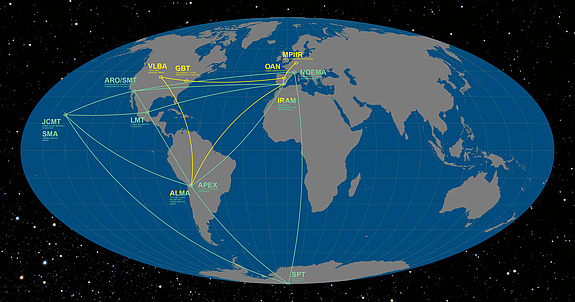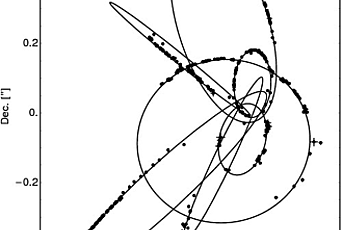How the Event Horizon Telescope Showed Us a Black Hole

On April 10, 2019, we were presented with the first-ever close-up image of a black hole by the Event Horizon Telescope (EHT). This remarkable technological achievement was made possible by the collective efforts of hundreds of astrophysics, engineers, and computer scientists. They arranged for simultaneous observations of their target with multiple telescopes around the globe and correlated the data between the instruments to effectively achieve the creation of a planet-sized telescope. The data was then processed to make the image we saw in the news.
But did we really “see” a black hole when we were shown “just” a digital image? And how is it possible to create an Earth-sized telescope?
Let me start by explaining why EHT really needed an Earth-sized telescope. An abundance of dust exists between our telescopes and the observed black holes. This dust absorbs electromagnetic radiation of short wavelengths such as visible light (about 5.5 x 10-7 m), infrared light (about 10-6 m), and so on. However, the radiation of wavelengths of about 1 millimeter (10-3 m) and larger is not affected by the dust. The angular resolution of a telescope is proportional to the observed wavelength divided by the diameter of the telescope. A longer wavelength results in lower resolution, while a bigger telescope mirror ensures higher resolution. ETH, therefore, had to observe a wavelength of around 1 mm. (They observed at 1.3 mm.) However, this wavelength also implied that they needed a telescope similar in size to the diameter of our planet to resolve the black hole shadow. It is not practically possible to construct a mirror of such a size, but we can still achieve the required resolution, using the interferometer technique. To explain it, we will use a series of analogies.
First analogy: Imagine a real telescope mirror equivalent to the size of planet Earth and then placing over it a black cloth with several holes. The cloth would limit the telescope’s capabilities and reduce its light-collecting area, but we still would have a mighty planet-sized telescope with high-resolution capabilities.
Second analogy: Imagine a handful of small mirrors. One can place them together tightly and construct a nice medium-sized telescope mirror. But one can also choose to scatter them across a larger area. Each small mirror represents a place where the fabric from the first analogy has a hole. Thus, if one finds a smart way of connecting the small mirrors and analyzes the data collected by each of them together, one may be able to reproduce the capabilities (in particular, the resolution) of the large mirror similar in size to the area across which the mirrors were scattered. Additionally, in moving the small pieces around, one would cover more and more of the surface of the large mirror and thus get closer and closer to its full capabilities.
This is a toy illustration of how an interferometer works. EHT simultaneously collects the data from multiple telescopes spread across our planet and then correlates and analyzes the data from them jointly. The involved telescopes also change their relative positions with respect to the target due to the Earth’s rotation covering larger parts of the Earth-sized mirror.
Over the history of astronomical observations, we have learned to employ and trust technology to help us study the sky. The first observations were done with unaided eyes only. Then optical telescopes magnified the image and increased the light-collecting area from the pupil size to the size of the lens (and later the mirror) so smaller and fainter objects became visible in detail. The films (and other receivers) afforded us much longer exposures than capable by the human eye. The films and receivers also allowed us to look outside the range of visible spectra, which was extremely useful to the study of celestial objects. (As the product of evolution on our particular planet, our eyes are strategically designed to be sensitive to the radiation from the Sun with a complete disregard of whether it is a good frequency range for the study of the rest of the universe.) Interferometers are just the next step in the evolution of visual aids. Therefore, we indeed “saw” a black hole although we were shown “just” a post-processed digital image.
It is true that science-wise the image of M87’s black hole did not teach us anything unexpected. It looked exactly as predicted. But perhaps this is not a bad thing. When the Large Hadron Collider in CERN started operating, it had to rediscover all the previously discovered particles. Only then, could it be trusted to search for unknown particles and to probe new physics. The first EHT image was proof of the value of new technology, and it passed the test. Should the subsequently released image show something unexpected and new, we will be more inclined to dive into its physical implications rather than questioning what went wrong with the observation. (Such a discovery, which matches predictions so well, has also, hopefully, demonstrated to the world in this age of anti-science that experts likewise should be trusted.)
What is next for the EHT? The other long-anticipated, and I would argue, more exciting target, is our own black hole in the center of our Milky Way galaxy known as Sagittarius A* (Sgr A*)—the subject of my own research at the Institute. Sgr A* is the closest supermassive black hole to Earth. It is located 26,000 light years away and has a mass 4,000,000 times that of the Sun. In contrast, M87’s black hole is 2,000 times further away and is 1,600 times more massive, but the sizes of the shadows of the black holes are similar. The mass of Sgr A* was deduced from the orbits of the nearby stars, which were tracked for twenty-five years, and scientists concluded that the object around which they orbit is so massive and so small that it can be nothing but a black hole. (Professor Scott Tremaine wrote more on this subject in his article “The Odd Couple: Quasars and Black Holes” for the Institute Letter in 2015).
A puzzling side of the behavior of Sgr A* is its accretion, namely, the behavior of in-falling gas. Here I would like to point out that the black hole does not suck in any material. The material falls into it by itself. In the same way, Earth does not suck up the International Space Station, which closely orbits it. The station experiences friction with the outer layers of the planet’s atmosphere, which slows it down causing its orbit to sink lower; in order to stay in space, it has to be re-boosted, i.e., moved to a higher orbit, regularly. The gas clouds orbiting the black hole also experience the same kind of friction, get heated, slow down, and move closer and closer to the back hole, until they fall in. They, so to say, accrete onto or feed the black hole. The gas clouds also radiate the excessive heat while spiraling down, thus producing the emission we call black hole radiation. (The Hawking radiation from the black holes is hopelessly overwhelmed by the radiation of the accreting gas.)
The amount of the hot gas (about ten million Kelvin), which is bound to Sgr A*, is well constrained by X-ray observations. If this gas fed the black hole in the usual way, we would see a few orders of magnitude more radiation than we actually observe. It was therefore concluded that it spirals into the black hole faster than it can radiate the heat, because the density of the gas is low, and thus the amount that is getting fed to the black hole can be larger than we would normally infer from the amount of observed radiation. The particular details of the process, however, are still uncertain. We still do not know whether there is a radial outflow from Sgr A*; whether it has jets; what the velocity of the gas flow around it and the direction of the flow are at the various radii; whether the flow forms a disk or not; how the density and temperature of the gas and the strength of magnetic fields change with the distance from the black hole; and how much of the gas, which is too cool to emit X-rays, is present near the black hole. The last area is the subject of my own studies.
There are several unresolved questions concerning the feeding of our supermassive black hole, which EHT observations will be able to help answer. For instance, we will learn about the presence or absence of Sgr A* jets and confirm the direction of the gas flow rotation and its inclination (it was recently claimed to be face-on). Overall, it would open a completely new chapter in studying black hole physics. All in all, it is a true privilege to live in such an exciting and dynamic time for this wonderful field.
No one can predict where the deeper understanding of fundamental laws that rule this world will lead us and what doors they will open, but it is always unexpected and exciting. It is worth remembering that the study of electricity was once considered a completely impractical endeavor, which would never have any useful applications. Now we tax it.


